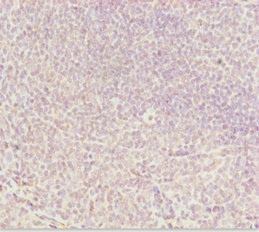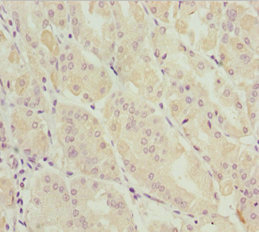Function
DNA-dependent ATPase and ATP-dependent DNA helicase that participates in various functions in genomic stability, including DNA replication, DNA repair and heterochromatin organization as well as in ribosomal RNA synthesis. Its double-stranded DNA helicase activity requires either a minimal 5'-single-stranded tail length of approximately 15 nt (flap substrates) or 10 nt length single-stranded gapped DNA substrates of a partial duplex DNA structure for helicase loading and translocation along DNA in a 5' to 3' direction. The helicase activity is capable of displacing duplex regions up to 100 bp, which can be extended up to 500 bp by the replication protein A (RPA) or the cohesion CTF18-replication factor C (Ctf18-RFC) complex activities. Shows also ATPase- and helicase activities on substrates that mimic key DNA intermediates of replication, repair and homologous recombination reactions, including forked duplex, anti-parallel G-quadruplex and three-stranded D-loop DNA molecules. Plays a role in DNA double-strand break (DSB) repair at the DNA replication fork during DNA replication recovery from DNA damage. Recruited with TIMELESS factor upon DNA-replication stress response at DNA replication fork to preserve replication fork progression, and hence ensure DNA replication fidelity. Cooperates also with TIMELESS factor during DNA replication to regulate proper sister chromatid cohesion and mitotic chromosome segregation. Stimulates 5'-single-stranded DNA flap endonuclease activity of FEN1 in an ATP- and helicase-independent manner; and hence it may contribute in Okazaki fragment processing at DNA replication fork during lagging strand DNA synthesis. Its ability to function at DNA replication fork is modulated by its binding to long non-coding RNA (lncRNA) cohesion regulator non-coding RNA DDX11-AS1/CONCR, which is able to increase both DDX11 ATPase activity and binding to DNA replicating regions. Plays also a role in heterochromatin organization. Involved in rRNA transcription activation through binding to active hypomethylated rDNA gene loci by recruiting UBTF and the RNA polymerase Pol I transcriptional machinery. Plays a role in embryonic development and prevention of aneuploidy. Involved in melanoma cell proliferation and survival. Associates with chromatin at DNA replication fork regions. Binds to single- and double-stranded DNAs.; (Microbial infection) Required for bovine papillomavirus type 1 regulatory protein E2 loading onto mitotic chromosomes during DNA replication for the viral genome to be maintained and segregated.
Gene References into Functions
- DDX11 orchestrates jointly with 9-1-1 and its loader, RAD17, DNA damage tolerance at sites of bulky lesions, and endogenous abasic sites. These functions may explain the essential roles of DDX11 and its similarity with 9-1-1 during development. PMID: 30061412
- We present two new cases of Warsaw Breakage Syndrome (WABS), an autosomal recessive cohesinopathy, in sisters aged 13 and 11 years who both had compound heterozygous mutations in DDX11 PMID: 28960803
- A mutation has been identified in HPV16 E2 that abrogates interaction with ChlR1, and it was shown that ChlR1 regulates the chromatin association of HPV16 E2 and that this virus-host interaction is essential for viral episome maintenance. PMID: 27795438
- In this study, we found that cohesion establishment factors, like CHlR1, cooperatively stimulate endonuclease activity of hFen1 in in vivo mimic condition, including replication protein-A-coated DNA and high salt. PMID: 26032365
- DDX11 and Tim proteins physically and functionally interact and act in concert to preserve replication fork progression in perturbed conditions. PMID: 26503245
- Q Motif Is Involved in DNA Binding but Not ATP Binding in ChlR1 Helicase PMID: 26474416
- our results indicate that DDX11 functions as a positive regulator of rRNA transcription and provides a novel insight into the pathogenesis of WABS. PMID: 26089203
- A distinct triplex DNA unwinding activity of ChlR1 helicase. PMID: 25561740
- ChlR1 plays a critically important role in cellular replication and/or DNA repair. [review] PMID: 24487782
- Data indicate a homozygous mutation (c.788G>A [p.R263Q]) in DDX11 in three affected siblings with severe intellectual disability and many of the congenital abnormalities reported in the Warsaw breakage syndrome (WABS) original case. PMID: 23033317
- helicase DDX11 is expressed at high levels in primary and metastatic melanoma, and that interfering with its expression leads to severe chromosome segregation defects, telomere shortening, and massive melanoma cell apoptosis. PMID: 23116066
- The results identify novel roles of Ddx11 during embryo morphogenesis and demonstrate that the activity of its motif V is essential for DDX11 function. PMID: 22678773
- Wild-type ChlR1 required a minimal 5' single-stranded DNA tail of 15 nucleotides to efficiently unwind a simple duplex DNA substrate. PMID: 22102414
- The ChlR1 is involved in the proper formation of heterochromatin, which in turn contributes to global nuclear organization and pleiotropic effects. PMID: 21854770
- These data provide evidence that the association of bovine papillomavirus E2 with human ChlR1 contributes to a loading mechanism during DNA replication rather than direct tethering during mitotic division. PMID: 21489590
- Timeless associates with the cohesion-promoting DNA helicase ChlR1, which, when overexpressed, partially alleviates the cohesion defect of cells depleted of Timeless-Tipin. PMID: 20124417
- We present preliminary analysis of a strong candidate gene in the region, the DNA helicase DDX11. In conclusion, we report mapping of the first locus that determines mean telomere length in humans. PMID: 15520935
- human ChlR1 is required for sister chromatid cohesion and, hence, normal mitotic progression. PMID: 17105772
- These studies provide compelling evidence that ChlR1 association is required for loading the papillomavirus E2 protein onto mitotic chromosomes and represents a kinetochore-independent mechanism for viral genome maintenance and segregation. PMID: 17189189
- hChlR1 has a role in the establishment of sister chromatid cohesion, with Ctf18-RFC and Fen1 PMID: 18499658
Show More
Hide All
Involvement in disease
Warsaw breakage syndrome (WBRS)
Subcellular Location
Nucleus. Nucleus, nucleolus. Cytoplasm, cytoskeleton, spindle pole. Midbody. Cytoplasm, cytoskeleton, microtubule organizing center, centrosome.; Chromosome.
Protein Families
DEAD box helicase family, DEAH subfamily, DDX11/CHL1 sub-subfamily
Tissue Specificity
Expressed in melanoma cells. Not detected in epidermal melanocytes of normal skin (at protein level). Highly expressed in spleen, B-cells, thymus, testis, ovary, small intestine and pancreas. Very low expression seen in brain. Expressed in dividing cells







